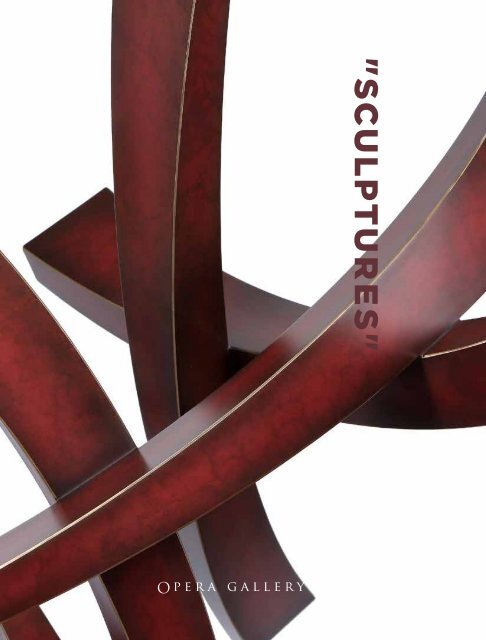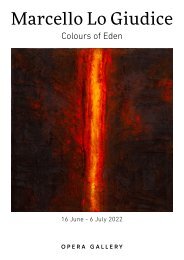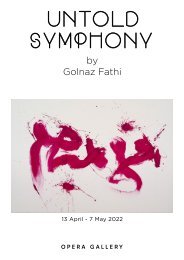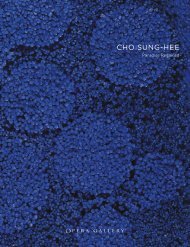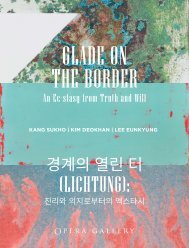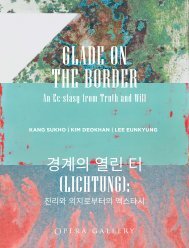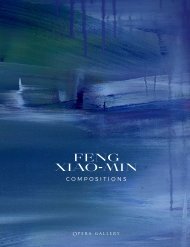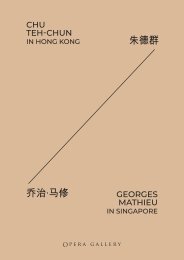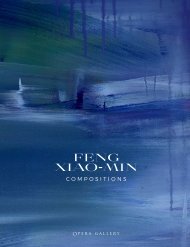"Sculptures"
Opera Gallery Dubai 18 - 31 March 2020
Opera Gallery Dubai
18 - 31 March 2020
You also want an ePaper? Increase the reach of your titles
YUMPU automatically turns print PDFs into web optimized ePapers that Google loves.
"SCULPTURES"
Preface<br />
Opera Gallery Dubai is excited to present its first ever Sculptures exhibition.<br />
Since the dawn of art practice, sculpture has been an important medium of expression.<br />
Over centuries, artists from all over the world have expressed their vision and ability using<br />
multi-dimensional form utilising all manner of materials including wood, clay, stone and bronze,<br />
to name a small selection.<br />
Our fascination with the natural world has, from very early on, prompted artists to emulate what<br />
they see. Sacred images are common in many cultures with sculptures found in evidence from<br />
all ancient civilisations. Whilst arguably, for a long time, sculptors did not share the same level of<br />
prestige as painters, their status changed during the high Renaissance era, where recognition<br />
was elevated to the same level as their peers.<br />
The historical importance of sculpture is widely reflected in museum displays, which regardless<br />
of their nature (art, anthropology, history, etc…) feature in permanent collections.<br />
More recently, during Modernism, sculpture moved to the forefront of art practice and<br />
appreciation, thanks to masters like Modigliani, Brancusi, Picasso, Calder and Duchamp amongst<br />
others. New materials and elaboration from the primary perception or function of sculpture<br />
have allowed artists to craft works that have become iconic and permanent fixtures of the art<br />
pantheon. Nowadays, sculpture parks achieve the same notoriety and acclaim as museums, with<br />
sculpture achieving unprecedented levels of interest from collectors and institutions alike.<br />
Sculptures has been curated to encompass selected pieces from important artists, highlighting<br />
a broad spectrum of medium and expression. We invite you to revisit iconic works of Modigliani<br />
and Rodin, and discover Contemporary pieces from artists such as Anthony James, Manolo<br />
Valdés or Valay Shende.<br />
Gilles Dyan<br />
Founder and Chairman<br />
Opera Gallery Group<br />
Sylvain P. Gaillard<br />
Director<br />
Opera Gallery Dubai<br />
3
The many languages of sculpture<br />
Maria Vezza<br />
To sculpt is to shape matter, to remove it, to stretch and transform it.<br />
To give it meaning, sometimes as an act of urgency, when words do<br />
not suffice. What does a sculptor express through the material they<br />
work with? “The essential idiom of the poem, the piece of music, of<br />
the painting or sculpture is that of survival,” wrote Georges Steiner<br />
in his book Real Presences. So is marble carved out of necessity<br />
or wood in a state of urgency? What survival, or evidence does<br />
sculpture express?<br />
1. Manolo Valdés, Reina Mariana, 2017,<br />
bronze, edition of 9, 180 x 120 x 135 cm -<br />
70.9 x 47.2 x 53.1 in, Château Saint-Martin<br />
& Spa, Vence, France, May - October 2019<br />
2. Fernando Botero, Horse, 1992, bronze,<br />
2 artist proofs, 154.9 x 109.2 x 68.6 cm -<br />
61 x 43 x 27 in<br />
Manolo Valdés’ works are rooted in history: filled with references<br />
to Western art, they evoke an artistic trend or academic genre.<br />
In 2005 the Spanish artist exhibited his twenty-one Meninas [1] at<br />
the gardens of the Palais Royal in Paris, France. These works were<br />
inspired by the famous painting by Diego Velázquez, whose work<br />
is preserved at the Prado Museum in Madrid, Spain. A supporter of<br />
the American Pop Art movement, the Spanish artist contributed to<br />
its transposition to Europe where he founded the collective Equipo<br />
Crónica in 1964, along with Rafael Solbes and Juan Antonio Toledo.<br />
He made numerous portraits of women, in a tradition derived from<br />
Renaissance portraits, enhancing their sensuality with the addition<br />
of large earrings or huge headdresses, like the one showing a<br />
cloud of butterflies. His bronzes utilise different coloured patinas:<br />
white, golden or even blue, a colour that is particularly pertinent<br />
in his work and is always employed in a referential context. It was<br />
the prominent colour used by the ancient Greeks, of representing<br />
truth for the Egyptians, of purity in the Christian tradition, or that of<br />
dreams in psychoanalysis. Blue is imbued with a range of meanings<br />
and allows us to read Manolo Valdés’ works at different levels. The<br />
story Fernando Botero’s work recounts is more geographically<br />
situated. The Colombian painter and sculptor, who defines himself<br />
as the “Most Colombian of Colombian artists”, likes painting the<br />
prosaic experience of Colombian society or bullfighting scenes.<br />
The recurrent painted or sculpted forms Fernando Botero creates<br />
are curvaceous, simplified, smooth and generous as with his<br />
monumental Bronze Horse (1999). Designed in the continuity of<br />
his body of painting, this sculpture has been recreated at various<br />
scales [2] . While both of these artists create figurative works, sculptors<br />
also express themselves in various ways through their works. Some<br />
even use text. This was the case for Robert Indiana, who recently<br />
passed away. He is an artist known worldwide for his Pop “LOVE”<br />
totems, with their iconic typography that has been widely emulated.<br />
He created them in every size and format, and the word “Love”<br />
became a sort of fetish for the artist, who was already using it in the<br />
postcards he designed in the 1960s. Commercial Pop Love, directly<br />
inspired by capitalist consumer society during the “Thirty Glorious<br />
Years” in the United States, is completely different from the subjects<br />
depicted by the Italian painter and sculptor Amedeo Modigliani,<br />
who is forever associated with the myth of the struggling artist. His<br />
sculptures depict faceless men and women who are so thin they<br />
seem to be constantly on the verge of collapsing. The artist lived<br />
5
3. Seon-Ghi Bahk, An Aggregate 201103,<br />
2011, charcoal, nylon threads and<br />
stone, unique piece, 270 x 45 x 45 cm -<br />
106.3 x 17.7 x 17.7 in (detail)<br />
in Paris in extremely difficult circumstances—his work encountered<br />
little success during his lifetime—and he expressed his suffering in<br />
his visual creations. Amedeo Modigliani was not the only artist to<br />
endure the human condition misery and economic precariousness he<br />
represents in his works; the contemporary artist Marc Sijan also works<br />
on this theme. Fascinated by anatomy and biology, the American<br />
sculptor makes hyper-realistic works using plaster moulds created<br />
on living models. Once he has cast the figure in resin, he covers it<br />
in several layers of paint and varnish. Disturbingly realistic, Sijan’s<br />
sculptures seem to be alive, about to move, and they depict people<br />
like male or female cleaners, who are often overlooked or even<br />
forgotten in Western society. Beyond their value as sculptures, these<br />
works recall the often precarious nature of existence and speak of a<br />
capacity for survival. Hence, sculpture speaks of us; it recounts our<br />
past, our personal history and the wider history of our times.<br />
Without overtly claiming to be activists, some artists choose to<br />
address burning contemporary issues. Thus, in the current alarming<br />
and unstable ecological context, Seon-Ghi Bahk and Bia Doria’s<br />
works seem to represent things that are already lost: the former’s<br />
installation-sculptures, made of floating pieces of charcoal [3] , echo<br />
the Korean tradition of purification, of warding off of spirits through<br />
the use of this material. The artist employs it as a basis for his<br />
reflections on the connection between humans and nature. Bia Doria<br />
draws her inspiration directly from the Brazilian forests: moved by the<br />
wave of deforestation in Amazonia (which rose by a phenomenal 85%<br />
in 2019), the artist sculpts small gashes in the wood of indigenous<br />
trees saved from incineration or deforestation. Will this deforestation<br />
force humanity to replace vegetal material with man made avatars?<br />
By ersatz similar to Lee Gil-Rae’s torturous trees [4] ? Made of pieces<br />
of copper soldered together, the South Korean artist’s trees stand as<br />
so many artificial simulations of a disappearing nature. So does this<br />
make sculpture the final evidence of ancient traditions and a declining<br />
nature in an increasingly globalised world?<br />
5. Pablo Atchugarry, La Pietà, 1982,<br />
Carrara marble<br />
While certain sculptors invite us to view our world through their<br />
works, we can also simply marvel at their art as an aesthetic<br />
expression. The construction and equilibrium that emanates from<br />
John Helton’s bronze sculptures contributes to embellishing our<br />
environment through its rhythm, spatial dynamics or even its gravity.<br />
Without being a clearly perceptible expression or language, the<br />
American artist’s sculptures infiltrate our collective unconscious, like<br />
the works of Henry Moore, to lastingly implant its shapes and forms<br />
into our conciousness. Famous for his monumental sculptures that<br />
dot public spaces in his homeland Uruguay, Pablo Atchugarry is<br />
captivated by materials, particularly marble. His sculptures explore<br />
the many ways of making it reflect, vibrate and respond to light.<br />
However, although he is better known for his abstract, vertically<br />
climbing works, Atchugarry anchors his sculptures in a sculptoral<br />
lineage: Michelangelo is his “conceptual mentor”. The famous Pietà,<br />
created by the Italian artist between 1498 and 1499, pervaded his<br />
mind to such an extent that Pablo Atchugarry has reinterpreted it<br />
innumerable times, with each representation more luminous than the<br />
last [5] . Unlike the Uruguayan sculptor who works on his material to<br />
display it in natural light, the British artist Anthony James seeks to<br />
explore the potential of artificial illumination. Constructed following<br />
precise mathematical principles, the artist’s sculptures are made<br />
of highly contemporary materials including LED [6] , and with this he<br />
states that art is timeless, but has multiple languages.<br />
As a language of survival, sculpture is also the language of the<br />
evidence of artistic, religious and popular traditions. It is the<br />
evidence of a conscience, the conscience of artists, who continue to<br />
warn us about the state of our world, and to teach and enthral us.<br />
4. Lee Gil-Rae’s project,<br />
KB SaChun Training Institute,<br />
South Korea, 2012<br />
6. Anthony James,<br />
70’’ Dodecahedron, 2019,<br />
powder coated stainless steel,<br />
glass and LED,<br />
177.8 x 177.8 cm - 70 x 70 in<br />
(detail)<br />
6<br />
7
AMEDEO MODIGLIANI<br />
(1884-1920)<br />
Amedeo Modigliani was born in 1884 in Livorno, Italy. He is celebrated for his iconic portraits,<br />
which, with often mask-like faces, have become iconic works of the early 20 th century. Inspired by<br />
Existentialist philosophy and a rejection of his bourgeois childhood, Modigliani chose not to paint<br />
landscapes, like many of his contemporaries, using portraiture instead to explore both his own<br />
psychology and that of his subjects, who were typically fellow artists or lovers. Modigliani also<br />
painted highly sexualised female nudes which at the time, were daringly erotic. His style is figurative<br />
but also highly expressive, and his subjects are shown with quirks and asymmetries, recalling the<br />
portraiture of Paul Cézanne, whose work Modigliani greatly admired. Modigliani befriended Pablo<br />
Picasso after moving to Paris in 1906, and like Picasso, he drew inspiration from the art of so-called<br />
‘primitive’ cultures, with his work often resembling African or Pre-Columbian statuary.<br />
Tête de Femme<br />
1910<br />
Signed on the lower part of the sculpture<br />
Bronze with black patina<br />
Edition of 8 + 4 artist proofs<br />
H: 55 cm - 21.7 in<br />
PROVENANCE<br />
Jeanne Modigliani<br />
Private collection, London<br />
Private collection<br />
CERTIFICATE<br />
Jeanne Modigliani has confirmed the authenticity of this work<br />
8
FERNANDO BOTERO<br />
(B. 1932)<br />
Fernando Botero is one of the most prominent and celebrated Latin American artists in the world.<br />
He was born in Medellín, Colombia, in 1932 and was only sixteen years old when his drawings were<br />
first published in a popular local newspaper. In 1958, he rose to national prominence when he won<br />
the first prize at the Salón de Artistas Colombianos, and during the subsequent four decades, he<br />
achieved international recognition for his contribution to Latin American art and culture.<br />
His signature ‘Boterismo’ style, depicting figures with exaggerated volume in staged scenari,<br />
represents an acute social and political critique alongside the more prosaic aspect of Colombian<br />
life. Recurrent themes address family life, religion, bullfight, and circus culture, all filtered through<br />
his unique, darkly humorous lens. His art is included in important private collections alongside<br />
numerous major museums collections. In 2012, he was awarded the International Sculpture Center’s<br />
Lifetime Achievement Award.<br />
Caballo<br />
2005<br />
Incised with the artist’s signature and numbered on the base<br />
Bronze<br />
Edition of 6<br />
86.4 x 101.6 x 50.2 cm - 34 x 40 x 19.8 in<br />
PROVENANCE<br />
Daniel Maman Fine Art, Miami<br />
Private collection, 2013<br />
CERTIFICATE<br />
The artist has confirmed the authenticity of this work<br />
10
MANOLO VALDÉS<br />
(B. 1942)<br />
Manolo Valdés is a painter, sculptor and mixed-media artist born in 1942 in Valencia, Spain.<br />
He studied for two years at the Escuela de Bellas Artes de San Carlos, where he established the<br />
artists’ group Equipo Crónica with Joan Antoni Toledo and Rafael Solbes.<br />
Influenced by historical masterpieces, Valdés creates large works in which the lighting and colours<br />
express a sensation of tactility. His work is forceful and decorated with historical art symbols.<br />
The timelessness of the image as the axis of the visual experience is the determining factor in his<br />
creations. In his works, image and matter are fused in a body of work that wanders between Pop Art<br />
and material art, between social and political commitment and a continuous search for reinvention.<br />
Throughout his long career, Valdés has never stopped investigating and reinventing Art, with an<br />
insatiable appetite for conceptual and plastic experimentation.<br />
Valdés’ works feature in numerous public and private collections such as, among others, the Peggy<br />
Guggenheim Collection, Venice, Italy; the Metropolitan Museum of Art, New York, USA; the Centre<br />
Georges Pompidou, Paris, France; or the Museo Nacional Centre de Arte Reina Sofía, Madrid, Spain.<br />
The artist currently lives and works in New York, USA.<br />
Golden Butterfly II<br />
2017<br />
Signed and numbered on the back, bottom left side<br />
24K gold gilded brass<br />
Edition of 9<br />
66 x 38 x 33 cm - 26 x 15 x 13 in<br />
PROVENANCE<br />
Artist’s studio<br />
12
Clio<br />
2017<br />
Signed and numbered on the back, bottom left side<br />
Alabaster and iron<br />
Edition of 9<br />
96 x 200 x 70 cm - 37.8 x 78.7 x 31.5 in<br />
PROVENANCE<br />
Artist’s studio<br />
14
Reina Mariana<br />
2017<br />
Signed on the back, bottom right side<br />
Bronze<br />
Edition of 9 + 4 artist proofs<br />
180 x 120 x 135 cm - 70.9 x 47.2 x 53.1 in<br />
PROVENANCE<br />
Artist’s studio<br />
16
Mariposas Azules II<br />
2017<br />
Signed and numbered on the back, bottom right side<br />
Painted bronze<br />
Edition of 9<br />
57 x 94 x 26 cm - 22.4 x 37 x 10.2 in<br />
Mariposas Plateadas<br />
2017<br />
Signed and numbered on the back, in the middle of the head<br />
Bronze<br />
Edition of 9<br />
38 x 59 x 18 cm - 15 x 23.2 x 7.1 in<br />
PROVENANCE<br />
Artist’s studio<br />
PROVENANCE<br />
Artist’s studio<br />
18<br />
19
ROBERT INDIANA<br />
(1928 – 2018)<br />
Born Robert Clark in Newcastle, Indiana, USA, in 1928, Robert Indiana is a preeminent figure in<br />
American art. Associated mostly with the Pop Art movement, Indiana also played a central role in<br />
the development of Assemblage Art. After moving to New York in 1966, the artist adopted the last<br />
name Indiana (reference of his place of birth) as a statement about the concept of home, a subject<br />
that has persisted throughout his career. Few Pop images are more recognisable than Robert<br />
Indiana’s LOVE, originally designed as a print image for the MoMA holiday card in 1965. Adopted<br />
as an emblem of 1960s idealism and full of erotic, religious and autobiographical meaning, LOVE<br />
is at once accessible and complex, an iconic symbol of hope that has become an intricate icon<br />
of contemporary culture. Since its inception in 1965, LOVE has been declined in various formats<br />
and renderings worldwide, including a reproduction in Spanish for the National Sculpture Garden<br />
in Washington D.C. and in Hebrew for the Israel Museum in Jerusalem. Its ubiquity worldwide<br />
emphasises the universality of the subject and explores one of Indiana’s central themes on the<br />
power of words and language. Renowned for simple, bold, memorable images, Indiana’s works have<br />
been collected in many international museums such as the Museum of Modern Art and the Whitney<br />
Museum of American Art in New York, USA ; the Ludwig Museum in Cologne, Germany and the<br />
Shanghai Art Museum in China.<br />
Love (Gold/Blue)<br />
1966 - 2002<br />
Stamped with the artist’s signature, numbered and dated on the inside of the 'E'<br />
Polychrome aluminium<br />
Edition of 6<br />
91.4 x 91.4 x 45.7 cm - 36 x 36 x 18 in<br />
PROVENANCE<br />
Gallery Hyundai, Seoul<br />
Private collection, New York<br />
Private collection<br />
20
ALEX KATZ<br />
(B. 1927)<br />
Alex Katz was born in 1927 in Brooklyn, New York, USA, to a Russian family. A true child of the<br />
Five Boroughs, Katz grew up in the St. Albans suburbs in Queens and graduated from Manhattan’s<br />
Copper Union in 1949 where he studied Modern Art theories and techniques under Morris Kantor.<br />
Katz’s experience of plein air painting at the Skowhegan School in Maine was pivotal in his<br />
development as a painter. The artist experiments with colour – using monochrome backgrounds<br />
in his artworks early on, dimensions, scale and materials. From the 1950s and on, Katz worked on<br />
a range of subjects and genres such as portraits, landscapes and still life such as flowers. His wife<br />
and muse, Ada, is often represented in his paintings. The painter reduces scenes or movement<br />
unto a flat surface with clean-cut contours. Katz also experimented with designing theatre sets<br />
and costumes. Considering himself a Post-Abstract painter, Katz is interested in exploring how<br />
“realism” can be redefined.<br />
His work has been exhibited extensively since the 1950s. The painter’s work from different decades<br />
of his career and on various medium were subject of museum exhibitions at renowned institutions<br />
such as the Tate Gallery and the National Portrait Gallery in London, UK ; the Guggenheim Museum<br />
in Bilbao, Spain ; the Albertina Museum in Vienna, Austria and the Metropolitan Museum of Art,<br />
New York, USA. He has received many awards throughout his lauded career and his work features<br />
in more than 100 public collections worldwide.<br />
Black Dress 1 (Yi)<br />
2018<br />
Incised with the artist signature and stamped on the base<br />
Powder coated aluminium<br />
Edition of 35<br />
59 x 20 x 8 cm - 23.2 x 7.9 x 3.1 in<br />
PROVENANCE<br />
Private collection, New York<br />
22
Black Dress Sculptures (2-9), 2018<br />
Incised with the artist signature and stamped on the base<br />
Powder coated aluminium<br />
Editions of 35<br />
First row, from left to right:<br />
Cecily<br />
61 x 20 x 8 cm - 24 x 7.9 x 3.1 in<br />
Oona<br />
61 x 18 x 8 cm - 24 x 7.1 x 3.1 in<br />
Sharon<br />
59 x 18 x 8 cm - 23.2 x 7.1 x 3.1 in<br />
Ulla<br />
61 x 16.5 x 8 cm - 24 x 6.5 x 3.1 in<br />
Second row, from left to right:<br />
Yvonne<br />
63.5 x 20 x 8 cm - 25 x 7.9 x 3.1 in<br />
Carmen<br />
63 x 21 x 8 cm - 24.8 x 8.3 x 3.1 in<br />
Ruth<br />
63 x 19 x 8 cm - 24.8 x 7.5 x 3.1 in<br />
Christy<br />
65 x 19 x 8 cm - 25.6 x 7.5 x 3.1 in<br />
24<br />
25
YUE MINJUN<br />
(B. 1962)<br />
Yue Minjun was born in 1962 in Heilongjiang, China. Yue graduated from the Oil Painting<br />
Department of Hebei Normal University. He is best known for his artwork in which he depicts<br />
him in various settings, frozen in laughter. He has reproduced this image signature in sculpture,<br />
watercolour and prints. His work engages the viewer with a kind of grey humour that emphasises<br />
the canvas’ boundaries as much as Yue’s ability for individualistic self-expression in oil painting.<br />
As original as his mocking self-portraits may be, Yue’s work shows a distinct penchant for art<br />
historical appropriation. Whether it is Eugène Delacroix or Francis Bacon that Yue chooses to<br />
emulate in a specific canvas, he does the artwork with a conflicting blend of respect and mockery<br />
that is typical of the Cynical Realism movement as a whole.<br />
The artist’s attitude toward the masterpieces from which he borrows, remains as ambiguous as his<br />
attitude towards the broken culture that surrounds him. At once clinging to and scorning it, Yue<br />
maintains a signature poker face throughout his entire oil paintings.<br />
Contemporary Terracotta Warriors 2<br />
2000<br />
Each signed in Pinyin, dated and numbered on the lower back<br />
Acrylic on fiberglass<br />
Edition of 25<br />
182 x 73 x 55 cm - 71.7 x 28.7 x 21.7 in<br />
PROVENANCE<br />
Rosewood collection, New York<br />
Private collection<br />
EXHIBITED<br />
Brussels, La Moutarderie Nationale, Collection Gillion Crowet, 2007 - 2019<br />
LITERATURE<br />
Zhang Qunsheng ed., Today’s Chinese Painters - Yue Minjun:<br />
The Lost of Self, Hebei Education Press, 2005, pp. 188-195 and p. 238, ill.<br />
26
MARC SIJAN<br />
(B. 1946)<br />
Marc Sijan was born in Serbia in 1946. He is currently based in Milwaukee, USA. The sculptor’s<br />
unique version of hyperrealistic portraiture has situated him as one of the most innovative,<br />
technically sophisticated and limitless American artists working today. Sijan received his BA in Art<br />
Education from the University of Wisconsin-Whitewater in 1968 and went on to earn his Master<br />
of Science in Art in 1971, undertaking an intense study of anatomy and biology. Sijan’s meticulous<br />
creative process begins with the construction of a plaster mould from a live model. He then uses<br />
a magnifying glass to sculpt the interior of the mould in order to assure accurate detail, before<br />
casting the figure in resin. Realistic flesh tones are then achieved with multiple layers of oil paint<br />
and varnish, a process that takes around six months to complete. The resulting creations are so lifelike<br />
as to almost be on the verge of movement.<br />
Communicating a deep sense of humanism, Sijan’s works stray from the traditional rules of<br />
Hyperrealism in its exclusion of narrative elements, human emotion and political value. The artist<br />
depicts people who are often overlooked by society, such as blue-collar workers, cleaning staff,<br />
and the overweight, turning the ordinary into inexplicable works of art. He does not shy from<br />
showing their imperfections, from pores in the skin and tiny hairs, to age spots and blemishes.<br />
In Sijan’s version of hyper-illusion, his sculptures become tender amalgamations of the elements<br />
that comprise each and every one of us, tangible stories from the gamut of humanity.<br />
Seated Guard (white shirt)<br />
2018<br />
Polyester resin and oil paint<br />
Unique piece<br />
142.2 x 53.3 x 61 cm - 56 x 21 x 24 in<br />
PROVENANCE<br />
Artist’s studio<br />
28
PABLO ATCHUGARRY<br />
(B. 1954)<br />
Pablo Atchugarry was born in 1954 in Montevideo, Uruguay. Working at first with cement and<br />
iron in the 1970s, he rose to prominence for his works in marble in the 1980s. He was awarded the<br />
Michelangelo Award from the city of Carrara, Italy, in 1999 for his artistic achievements in working<br />
with Carrara marble. The following year, he represented Uruguay at the 50 th Venice Biennale<br />
with the sculpture Soñando la Paz, an eightpiece work in Carrara and Bardiglio della Garfagnana<br />
marble. In 2007, the artist established the nonprofit institution Fundación Pablo Atchugarry in<br />
Manantiales, Uruguay, which promotes visual arts, music, and literature in the community.<br />
His work is exhibited in numerous museums and public institutions worldwide, including the<br />
National Museum of Visual Arts of Montevideo, Uruguay; the Parco Museum of Parco de Portofino,<br />
the Lercaro Museum of Bologna, the Collection of the Province of Milan, Italy; the Franc Daurel<br />
Foundation in Barcelona, Spain ; the Groeningemuseum in Bruges, Belgium; the Berardo Collection<br />
in Portugal; the Perez Art Museum in Miami, USA and the Chrysler Museum of Art in Norfolk, UK.<br />
Atchugarry’s works can be found in public and private collections internationally. He currently lives<br />
and work between Lecco, Italy, and Manantiales, Uruguay.<br />
Untitled<br />
2019<br />
Statuary Carrara marble<br />
Unique piece<br />
132 x 33 x 26 cm - 52 x 13 x 10.2 in<br />
PROVENANCE<br />
Artist’s studio<br />
30
Untitled<br />
2019<br />
Statuary Carrara marble<br />
Unique piece<br />
44 x 27 x 17 cm - 17.3 x 10.6 x 6.7 in<br />
PROVENANCE<br />
Artist’s studio<br />
32
Untitled<br />
2017<br />
Bronze with blue automative enamel<br />
Edition of 8<br />
123.5 x 29.5 x 13.5 cm - 48.6 x 11.6 x 5.3 in<br />
Untitled<br />
2018<br />
Bronze with yellow automative enamel<br />
Edition of 8<br />
92 x 31 x 27 cm - 36.2 x 12.2 x 10.6 in<br />
PROVENANCE<br />
Artist’s studio<br />
PROVENANCE<br />
Artist’s studio<br />
34<br />
35
JOHN HELTON<br />
(B. 1964)<br />
John Helton, born in 1964, has displayed a talent for creating beautiful works of art from a very<br />
young age. His father was also an artist and exposed him to the galleries and museums of nearby<br />
Manhattan, New York throughout his childhood. Helton soon gained an appreciation for the<br />
complex and abstract ideas of the Modern Masters. When, in 6 th grade science class, he learned<br />
that matter could neither be created nor destroyed, his perception of the world forever changed.<br />
“I began to see an interconnectedness beyond comprehension. I see the world as a vast<br />
collaboration, a symphony of energy that is in constant motion. My work is a visual metaphor for<br />
the rhythm of life.”<br />
After graduating from Parson’s School of Design, NYC, Helton found inspiration in the dramatic<br />
landscapes of the mountains and deserts of the West, where he maintains a studio to this day. His<br />
elegant and powerful sculptures are collected and exhibited internationally, and he continues to<br />
gain recognition as an important voice in Contemporary sculpture.<br />
Epiphany<br />
2019<br />
Bronze<br />
Unique piece<br />
304.8 x 162.6 x 116.8 cm - 120 x 64 x 46 in<br />
PROVENANCE<br />
Artist’s studio<br />
36
Threshold<br />
2019<br />
Bronze, gilded 24K gold leaf with black granite base<br />
Unique piece<br />
162.5 x 66 x 56 cm - 64 x 26 x 22 in (with base)<br />
PROVENANCE<br />
Artist’s studio<br />
38
Supernova<br />
2018<br />
Bronze with white marble base<br />
Unique piece<br />
198 x 81.3 x 81.3 cm – 78 x 32 x 32 in (with base)<br />
PROVENANCE<br />
Artist’s studio<br />
40
BENOIT LEMERCIER<br />
(b. 1965)<br />
French sculptor Benoit Lemercier is born in 1965. Lemercier has always been fascinated by manual<br />
work, including drawing and painting. This leads to his experimenting and learning how to handle<br />
various materials since a young age. At the age of sixteen, he created his first drawing The Periodic<br />
Classification of Elements inspired by chemistry. Since then, Lemercier began to associate art and<br />
science in his artworks trying to illustrate in a visible form the mysteries of the universe. He now<br />
lives and works in Paris and in Eauze in the Gers region, France.<br />
Benoit Lemercier brings to us an artistic vision of the world’s mysteries that surround us. Based<br />
on different scientific theories, he takes us on a journey into the heart of matter and presents a<br />
poetic vision of the infinitely grandiose and the infinitely small through series Hypercubes and<br />
Superstrings, which started in 2000. The Hypercubes series brings us towards the infinitely<br />
grandiose by playing with the anamorphic to venture into the fourth spatial dimension. Angular<br />
and black geometric sculptures open these perspectives to us and lead towards the infinite with<br />
radiating lines. The Superstrings series is a demonstration of the infinitely small made visible by the<br />
intermingling white bands showing the vibrations of the smallest particles of matter. The quantum<br />
string theory suggests that matter is made of vibrating microscopic strings that in turn create<br />
subatomic particles.<br />
Superstrings<br />
2006<br />
Painted steel<br />
Unique piece<br />
250 x 204 x 178 cm - 98.4 x 80.3 x 70.1 in<br />
PROVENANCE<br />
Artist’s studio<br />
42
Superstrings<br />
2017<br />
Painted steel<br />
Unique piece<br />
140 x 91 cm - 55.1 x 35.8 in<br />
PROVENANCE<br />
Artist’s studio<br />
44
ANTHONY JAMES<br />
(B. 1974)<br />
Anthony James is a British-American artist based in Los Angeles, known for his monumental<br />
installations and sculptures. He was born in England in 1974 and studied in London at Central<br />
Saint Martins College of Art and Design from 1994 to 1998. His work gestures towards minimalism,<br />
materiality, process, alchemy, language, mechanisation and experimentation with light and space.<br />
The Birch series of sculptures were debuted in New York City in 2005. They consist of several<br />
variously sized, freestanding and wall-mounted, internally illuminated, steel and glass vitrines with<br />
birch tree trunks inside. The birch tree is associated with magical symbolism. Many anthropologists<br />
consider it to be a possible agent of the transformation of human consciousness. The birch tree<br />
is also “associated with birth and rebirth” and is “hermaphroditic and self-propagating, with<br />
male and female flowers on the same tree”. His Portal sculptures take up the concepts of the<br />
universal and transcendental. The historical cosmology of Plato is a primary inspiration for the<br />
sculptures. The effect is both esoteric and scientific, morphic and distinctly concrete. The historical<br />
references here span the empirical experimentation of cultures. Icosahedrons – the geometric<br />
globes of twenty identical triangular faces – were a mathematical experiment in unity used by<br />
Plato to demonstrate an ideal compositional system of perfect symmetry in three dimensions. In a<br />
twenty-first century gallery space, the glass, steel, and LED structures bring a rigid and gleaming<br />
tangibility to the abstraction of the numerical calculation of flawless coherence. James’ objects<br />
are compelling approximations, facsimiles of understanding and belief thousands of years old that<br />
come down to us on our own terms of modern metals and technological light.<br />
Anthony James has exhibited in several international Museums. His first monograph, ‘Morphic<br />
fields’, was published by Hatje Cantz in 2014. His work has recently been exhibited at Crystal<br />
Bridges Museum, ‘Crystals in Art, ancient and today’, Bentoville, USA (October 2019 -<br />
January 2020), curated by Joachim Pissarro and Lauren Hayes.<br />
40" Icosahedron<br />
2019<br />
Stainless steel, specialised glass and LED lights<br />
Edition of 6 + 3 artist proofs<br />
101.6 x 101.6 x 101.6 cm – 40 x 40 x 40 in<br />
PROVENANCE<br />
Artist’s studio<br />
46
84" Wall Mounted Birch<br />
2019<br />
Stainless steel, specialised glass, LED and birch trees with an oak frame<br />
Unique piece<br />
76.2 x 213.4 x 38.1 cm - 30 x 84 x 15 in<br />
PROVENANCE<br />
Artist’s studio<br />
48
50" Octagon Wall Portal<br />
2019<br />
Powdercoated stainless steel, glass and LED lights<br />
Edition of 6 + 4 artist proofs<br />
127 x 127 cm - 50 x 50 in<br />
PROVENANCE<br />
Artist’s studio<br />
50
GIANFRANCO MEGGIATO<br />
(B. 1963)<br />
Gianfranco Meggiato was born in Venice, Italy, in 1963 where he attended the Istituto Statale<br />
d’Arte, studying stone, bronze, wood and pottery sculpture. At only fourteen years old he began<br />
exhibiting his artworks, participating in two collective art exhibitions in 1979 and 1984 at the<br />
Galleria Le Masa in Venice, Italy. Since then the artist has participated in hundreds of exhibitions<br />
worldwide, especially throughout Italy and Europe.<br />
Meggiato’s sculptures are dominated by void rather than surface - freedom is the ultimate value<br />
for the artist. “We are spiritual beings in direct relation with the energies of the universe because<br />
we are part of that energy”, as he points out. The “Maestro of Venice” creates complex abstract<br />
sculptures in lost wax cast bronze. He works by instinct and morphs the wax-made spaghetti reels<br />
into shape by using heated tools.<br />
Influenced by the undulating lines and reflective ponds of his homeland, Meggiato’s sculptures<br />
capture the essence of the Venetian bronze. Using the ‘lost wax’ process, a method of casting<br />
in which molted metal is poured into a mold that has been created by a wax model, the artist’s<br />
sculptures are preoccupied with the void rather than the surface. Contemplative and energetic,<br />
Meggiato’s sculptures are evocative of a classic tradition seeped in contemporary meaning.<br />
Stella del Mattino<br />
Bronze<br />
Edition of 9<br />
88 x 62 cm - 34.6 x 24.4 in<br />
PROVENANCE<br />
Artist’s studio<br />
52
VALAY SHENDE<br />
(B. 1980)<br />
Valay Shende is an Indian sculptor born in 1980 in Nagpur, India. He received his Diploma in Art<br />
Education in Nagpur in 2000, before graduating with a Bachelor of Arts in sculpture in 2004 from the<br />
Sir J.J. School of Art in Mumbai, India.<br />
His lifesize sculptural installations question the evils striking urban society, and especially his home<br />
country of India. Concerned with the man’s tribulations of everyday life, Shende’s keen observations<br />
reveal themselves through skillfully rendered objects, profiles and symbols. Meticulously crafted<br />
and articulate, his sculptures reveal an artistic, social and moral vision wrought with physical and<br />
metaphysical presence.<br />
His work has been exhibited widely in India and internationally. Valay Shende was notably awarded the<br />
2004 K.K. Hebbar Foundation Award, the First Prize at the India Sabka Festival in Mumbai in 2002, and<br />
the Best Sculpture Award from the All India Fine Arts & Crafts Society in New Delhi, in 2002.<br />
Auto Ricksaw<br />
2015<br />
Stainless steel discs and mixed media<br />
Edition of 5 + 2 artist proofs<br />
168 x 264 x 135 cm - 66.1 x 103.9 x 53.1 in (with base)<br />
PROVENANCE<br />
Artist’s studio<br />
54
SEO YOUNG-DEOK<br />
(B. 1983)<br />
Born in 1983 in Seoul, South Korea, Seo Young-Deok graduated in Environmental Sculpture from the<br />
University of Seoul and won the Grand Prix 2008 in the Student Environmental Sculpture competition.<br />
The metallic chains he uses have great symbolic power. The artist’s only medium, they are seamlessly<br />
welded, together leaving no visible structure. An archetype of the tool of restraint, the chain is also<br />
a symbol of the connection that binds people together. Seo Young-Deok questions the idea of<br />
individuality in our highly technical societies, where industrial materials no longer limited to encasing<br />
the body, but have now become its flesh. His series of anonymous mutilated bodies echoes the<br />
suffering and hardships his ancestors suffered during the period of industrialisation in Korea. The artist<br />
highlights the dichotomy and social inequalities the industrial system has inevitably given rise to.<br />
His works are exhibited internationally and feature in private and public collections such as the Sung kok<br />
Art Museum and the Harley Davidson Collection in Seoul or the Seongnam Arts Centre, South Korea.<br />
Meditation 626<br />
2018<br />
Iron chain<br />
Edition of 10<br />
200 x 135 x 120 cm - 78.7 x 53.1 x 47.2 in<br />
PROVENANCE<br />
Artist’s studio<br />
56
Self-Portrait 4<br />
2014<br />
Iron chain<br />
Edition of 8<br />
80 x 60 x 60 cm - 31.5 x 23.6 x 23.6 in<br />
PROVENANCE<br />
Artist’s studio<br />
58
Anguish 21<br />
2015<br />
Iron chain<br />
Edition of 8<br />
75 x 40 x 35 cm - 29.5 x 15.7 x 13.8 in<br />
PROVENANCE<br />
Artist’s studio<br />
60
LEE GIL RAE<br />
(B. 1961)<br />
Born in 1961 in Yeongam-gun, Korea, Lee Gil Rae studied fine art and sculpture at the University of<br />
Kyunghee in Seoul. He has spent more than twenty years perfecting delicate pine branches made<br />
of copper rings and lengths of pipe. The complexity of these organic shapes, inspired by the pine<br />
trees in ancient paintings and wood cuts, exude a certain poetry and lightness that contrast with<br />
the industrial material he uses. These metal trees raise questions related to deforestation and the<br />
environmental crisis provoked by human activity. These are subjects favoured by this generation<br />
of contemporary Korean artists. Lee Gil Rae’s murals and full-length works reveal their message<br />
when they are read at two levels, where aestheticism and lightness turn into a strong critique of<br />
our society.<br />
Lee’s works are exhibited all over the world and feature in various private and public collections,<br />
such as the Seoul Art Museum, the Savina Museum of Contemporary Art, the Samsung Foundation<br />
of culture in Seoul and the Pohang Museum of Art, South Korea.<br />
Pine Tree 2018-2<br />
2018<br />
Copper welding<br />
Unique piece<br />
253 x 115 x 85 cm - 99.6 x 45.3 x 33.5 in<br />
PROVENANCE<br />
Artist’s studio<br />
62
Pine Tree 2018-8<br />
2018<br />
Copper welding<br />
Unique piece<br />
230 x 98 x 50 cm - 90.6 x 38.6 x 19.7 in<br />
PROVENANCE<br />
Artist’s studio<br />
64
BAHK SEON-GHI<br />
(B. 1966)<br />
Born in 1966 in Sunsan, Bahk Seon-Ghi is a Korean sculptor and installation artist who lives and<br />
works in Gyeonggi-Do, South Korea.<br />
Following his graduation from Chung-Ang University in Seoul, he spent several years in Europe,<br />
studying sculpture at the Accademia di Belle Arti Brera in Milan, Italy and at Barnet and Southgate<br />
College in London, UK.<br />
Bahk is known for his monumental, ethereal installations using natural materials (mostly charcoal)<br />
to create everyday objects such as tables, staircases, frames and circles, which appear to float<br />
through light and space. Charcoal, his favorite material, is fundamental in this exploration - the<br />
natural substance holds traditional importance in Korean birth and death rituals. Bahk is an<br />
internationally reputed and established Contemporary Korean artist. He is the recipient of the<br />
2009 Kim Chong Yung Sculpture Award and was featured in solo exhibitions in Miami, Korea,<br />
Switzerland, Spain and China, to name just a few. His works are part of many prominent permanent<br />
collections worldwide.<br />
An Aggregate 201103<br />
2011<br />
Charcoal, nylon threads and stone<br />
Unique piece<br />
270 x 45 x 45 cm - 106.3 x 17.7 x 17.7 in<br />
PROVENANCE<br />
Artist’s studio<br />
66
BIA DORIA<br />
(B. 1960)<br />
Bia Doria was born in 1960 in Pinhalzinho, Brazil. She is a sculptor who creates works made of<br />
bronze, wood and marble. She draws inspiration from Brazilian nature and prefers to focus her<br />
art on sustainability. Holding natural forms and shapes as the core of her work, she re-forms and<br />
transforms forest waste as if these were polished diamonds, materials highly incompressible and<br />
hard to re-shape and obtain.<br />
A few years ago, Bia Doria filmed a documentary and produced a series of photos in Amazonia<br />
aiming to condemn the ecological catastrophe as a result of the construction of a hydroelectric<br />
power plant in the area.<br />
Her creative ventures result in art pieces made by forest waste management, sustainable products<br />
and native trees rescued from incineration, deforestation, river bottom and dams, among others.<br />
Bridging each work to its ideal condition and form is a prolonged process, as each one requires to<br />
be handled with attention and precision, from optimal preservation.<br />
BD-0239<br />
2019<br />
Wood<br />
Unique piece<br />
265 x 70 x 30 cm - 104.3 x 27.6 x 11.8 in<br />
PROVENANCE<br />
Artist’s studio<br />
68
BD-0199<br />
2018<br />
Wood<br />
Unique piece<br />
220 x 52 x 52 cm - 86.6 x 20.5 x 20.5 in<br />
BD-0200<br />
2018<br />
Wood<br />
Unique piece<br />
212 x 52 x 60 cm - 83.5 x 20.5 x 23.6 in<br />
PROVENANCE<br />
Artist’s studio<br />
PROVENANCE<br />
Artist’s studio<br />
70
Index<br />
AMEDEO MODIGLIANI<br />
FERNANDO BOTERO<br />
MANOLO VALDÉS<br />
Tête de Femme, 1910<br />
p. 9<br />
Caballo, 2005<br />
p. 11<br />
Golden Butterfly II, 2017<br />
p. 13<br />
Clio, 2017<br />
pp. 14-15<br />
Black Dress 6 (Yvonne),<br />
2018<br />
p. 24<br />
Black Dress 5 (Ulla),<br />
2018<br />
p. 25<br />
Black Dress 7 (Carmen),<br />
2018<br />
p. 25<br />
Black Dress8 (Ruth),<br />
2018<br />
p. 25<br />
Black Dress 9 (Christy),<br />
2018<br />
p. 25<br />
YUE MINJUN<br />
MARC SIJAN<br />
PABLO ATCHUGARRY<br />
Reina Mariana, 2017<br />
p.17<br />
Mariposas Azules II, 2017<br />
p.18<br />
Mariposas Plateadas, 2017<br />
p. 19<br />
Contemporary Terracotta<br />
Warriors 2, 2000<br />
p. 27<br />
Seated Guard (white<br />
shirt), 2018<br />
p. 29<br />
Untitled, 2019<br />
p.31<br />
Untitled, 2019<br />
p.33<br />
Untitled, 2017<br />
p.34<br />
ROBERT INDIANA<br />
ALEX KATZ<br />
JOHN HELTON<br />
Love (Gold/Blue),<br />
1966 - 2002<br />
p. 21<br />
Black Dress 1 (Yi), 2018<br />
p. 23<br />
Black Dress 2 (Cecily),<br />
2018<br />
p. 24<br />
Black Dress 3 (Oona),<br />
2018<br />
p. 24<br />
Black Dress 4 (Sharon),<br />
2018<br />
p. 24<br />
Untitled, 2018<br />
p.35<br />
Epiphany, 2019<br />
p. 37<br />
Threshold, 2019<br />
p. 39<br />
Supernova, 2018<br />
p. 41<br />
72
BENOIT LEMERCIER<br />
ANTHONY JAMES<br />
LEE GIL RAE<br />
Superstrings, 2006<br />
p. 43<br />
Superstrings, 2017<br />
p. 45<br />
40’’ Icosahedron, 2019<br />
p. 47<br />
Self-Portrait 4, 2014<br />
p. 59<br />
Anguish 21, 2015<br />
p. 61<br />
Pine Tree 2018-2, 2018<br />
p. 63<br />
Pine Tree 2018-8, 2018<br />
p. 65<br />
BAHK SEON-GHI<br />
BIA DORIA<br />
84’’ Wall Mounted Birch (Oak Frame), 2019<br />
pp.48-49<br />
50’’ Octagon Wall Portal, 2019<br />
pp.50-51<br />
An Aggregate 201103,<br />
2011<br />
p.67<br />
BD-0239, 2019<br />
p.69<br />
BD-0199, 2018<br />
p.70<br />
BD-0200, 2018<br />
p.71<br />
GIANFRANCO MEGGIATO VALAY SHENDE SEO YOUNG-DEOK<br />
Stella del Mattino<br />
p. 53<br />
Auto Ricksaw, 2015<br />
p. 55<br />
Meditation 626, 2018<br />
p. 57<br />
74
Published by Opera Gallery to coincide with the exhibition<br />
˝Sculptures˝, March 2020, Dubai.<br />
All rights reserved. Except for the purposes of review, no part<br />
of this book may be reproduced, stored in a retrieval system,<br />
or transmitted, in any form or by any means, electronic,<br />
mechanical, photocopying, recording or otherwise, without<br />
the prior permission of the publishers.<br />
Coordinator<br />
Lucile Bacon<br />
Victoria Noizet<br />
Texts<br />
Sylvain P. Gaillard<br />
Maria Vezza<br />
Translator<br />
Renuka George<br />
Proofreading<br />
Lucile Bacon<br />
Joseph Clarke<br />
Aurélie Heuzard<br />
Victoria Noizet<br />
Flavien Puel<br />
Designer<br />
Élisabeth Chardin<br />
Printer<br />
Delta Printing Press ME FZCO<br />
Cover<br />
Supernova, 2018, bronze,<br />
198 x 81.3 x 81.3 cm - 78 x 32 x 32 in (detail)<br />
NEW YORK<br />
791 Madison Avenue<br />
New York, NY 10065<br />
T. + 1 646 707 3299<br />
nyc@operagallery.com<br />
MIAMI<br />
151 NE 41st Street, Suite 131, Paradise Plaza<br />
Miami Design District<br />
Miami, FL 33137<br />
T. + 1 305 868 3337<br />
miami@operagallery.com<br />
BAL HARBOUR<br />
The St. Regis Bal Harbour Resort<br />
9703 Collins Avenue, Lobby Floor<br />
Miami Beach, FL 33154<br />
T. + 1 305 861 9022<br />
balharbour@operagallery.com<br />
ASPEN<br />
501 E Dean Street<br />
Residences at the Little Nell<br />
Aspen, CO 81611<br />
T. + 1 970 710 7289<br />
aspen@operagallery.com<br />
LONDON<br />
134 New Bond Street<br />
London W1S 2TF<br />
T. + 44 (0)20 7491 2999<br />
london@operagallery.com<br />
PARIS<br />
62 rue du faubourg Saint-Honoré<br />
75008 Paris<br />
T. + 33 (0)1 42 96 39 00<br />
paris@operagallery.com<br />
MONACO<br />
1 avenue Henri Dunant<br />
Palais de la Scala<br />
98000 Monaco<br />
T. + 377 9797 5424<br />
monaco@operagallery.com<br />
GENEVA<br />
Place de Longemalle 10-12<br />
1204 Geneva<br />
T. + 41 (0)22 318 57 70<br />
geneve@operagallery.com<br />
DUBAI<br />
Gate Village Building 3<br />
Dubai International Financial Centre<br />
Dubai<br />
T. + 971 (0)4 323 0909<br />
dubai@operagallery.com<br />
BEIRUT<br />
Foch 94, Foch Avenue<br />
Beirut Central District<br />
T. + 961 (0)1 971 471<br />
beirut@operagallery.com<br />
HONG KONG<br />
W Place, 52 Wyndham Street<br />
Central, Hong Kong<br />
T. + 852 2810 1208<br />
hkg@operagallery.com<br />
SINGAPORE<br />
2 Orchard Turn<br />
#02-16 Ion Orchard<br />
Singapore 238801<br />
T. + 65 6735 2618<br />
spore@operagallery.com<br />
SEOUL<br />
18 Eonju-ro 154 gil<br />
Gangnam-gu<br />
Seoul 06021<br />
T. + 82 (0)2 3446 0070<br />
seoul@operagallery.com<br />
www.operagallery.com
operagallery.com


